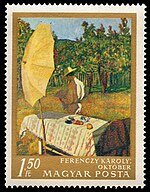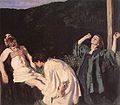Talk:Károly Ferenczy/Temp
This article contains close paraphrasing of non-free copyrighted sources. (November 2011) |

Untitled
Károly Ferenczy (February 8, 1862 – March 18, 1917) was a Hungarian painter, a leading member of the Nagybánya artists' colony.
Biography
Early life
Born in Vienna into a comfortable middle-class family who were the owners of a small estate in southern Hungary, it was the influence of his cousin, Olga von Fialka, who later became his wife, that led him to painting at the relatively late age of 22. The two travelled to Italy in 1885, spending some time in Naples, where he began studies at the Accademia di Belle Arti.[1] Briefly stopping in Munich in 1887, he met young Hungarian art students there (including Simon Hollósy and István Csók), all of them strongly influenced by Jules Bastien-Lepage.[1][2] This led him to study in Paris (1887–1889). Attending the Académie Julian, his professors were Tony Robert-Fleury and William-Adolphe Bouguereau, although Bastien-Lepage remained his greatest influence.[1]
Upon his return to Hungary in 1889, Ferenczy lived in Szentendre, where he began a series of large compositions in Bastien-Lepage's style. One of these is 1890's Kődobálók – "Boys Throwing Pebbles into the River", which art historian Ilona Sármány-Parsons calls "outstanding" and says it "radiates an everyday tranquillity". His works from this period "feature the use of a unifying pearl grey tone that binds together the pale tints and lends a gentle, pensive mood to the whole composition". Quickly becoming dissatisfied with his results, he left the seclusion of Szentendre in 1893. Hoping to find new inspiration, he moved to the vibrant artistic environment of Munich. Despite his aversion to the city's Bohemian circles, he at once embraced the plein-air style then popular. He renounced the grayish colors of the Munich school so favored by Hungarian painters, and although he continued to prefer overcast scenes, yet his colors became fresher and more vivid, and his brushwork softer. The first example of this more colorful approach is Madárdal – "Birdsong" (1893). Here, he "succeeded in harmonizing the human figure and the natural environment", a characteristic that henceforth became the recurring theme of his work. His most accomplished paintings depict "an idealized harmony between man and nature, placing the figures among luxuriant foliage in woods or gardens, and balancing tone, color and light to endow them with equal compositional weight to the natural world".[1]
At Nagybánya

Ferenczy left Munich in 1896 and returned to Hungary, settling in Nagybánya (now Baia Mare, Romania) along with a small group of other Hungarians from Munich who were students and friends of Hollósy. The latter became the first head of the Nagybánya artists' colony, which almost immediately drew notice from Budapest intellectuals. Acting upon a shared commission to illustrate the poems of contemporary popular poet József Kiss, Ferenczy executed four drawings and four paintings. Sármány-Parsons considers Nápolyi emlék – "Memory of Naples" (1896) the "most lyrical" of these, and calls the eight works "among the finest Hungarian book illustrations". They are for him a rare use of Art Nouveau, together with the earlier "poster-like" Archeológia – "Archaeology" (1896).[1]
By the time he moved to Nagybánya, Ferenczy had been painting en plein air for three years, while his comrades were at first slightly perturbed by their new milieu. He replaced Hollósy when the older man underwent a creative crisis; Ferenczy's "artistic achievements, steadiness and self-discipline" made him a "natural authority figure". The bitter and jealous Hollósy left the town in disgust in 1902. Plein-air, still unfamiliar in Hungary, did not immediately excite the public, but other artists and prominent critics were enthusiastic. Along with a number of other turn-of-the-century Munich artists, Ferenczy from time to time tried out new styles on the epic Biblical themes that were traditionally the most demanding. This was largely unrelated to conventional piety or gaining commissions;[1] indeed, Ferenczy was a rationalist and an atheist. He chose Bible scenes that had lost some of their original narrative power and significance, and through them could express his own inspired response to nature and the feelings he was too withdrawn to show more directly.[3] Religious paintings of the time tended to be naturalistic, often either "pathetic or banal", while those who tried for Symbolist interpretations usually produced work that was "rigid and imbued with an air of self-conscious archaism". However, Ferenczy's Háromkirályok – "The Three Magi" (1898) is, according to Sármány-Parsons, "unusually successful. Only the title reveals the identity of the three mysterious riders who are enveloped in the dark green shadows of dense woodland as darkness falls. They appear as mystical, enigmatic figures, melting into the trees as if in a dream. The effect is that of a profound and tranquil harmony, a pantheistic idyll."[1]
It was around 1901 that Ferenczy started to use a lighter palette and to depict sunlit scenes with large sections of vivid greens, blues and yellows. The "joy in the beauty of life and nature" that these brightly colored paintings emanate resembles that found among the French Impressionists' work. A signature composition from this period is Október – "October" (1903); "simple" and "lyrical", it shows a man reading a newspaper beneath a sunshade in a garden, the scene imbued with the autumn glow of an ordinary Central European Indian summer. "Despite the bold asymmetry of the large brilliantly colored areas of the sunshade and tablecloth, the composition possesses a sophisticated and reassuring balance. Its magic lies not only in the evocation of a soft autumnal atmosphere, but also in the integration of figure and background."[1]
In 1902, he began teaching at the painters' school in Nagybánya.[2] He held his first retrospective in Budapest in December 1903, and this very successful event was the apex of Ferenczy's career. In the preface to the show's catalogue, he defined his style as "coloristic naturalism on a synthetist basis".[1] Also that year, he tried to open his own school in Budapest, and he regularly participated in the main national art shows, also having his works displayed abroad alongside other Hungarian artworks.[2]
Later life

A few years later, the naturalistic components of his work became more stylized, acquiring a "highly formal organization of shape and color". His figures came to have "forced and unnatural" gestures and poses, and his palette became darker and more intense. Dupla portré (Béni és Noémi) – "Double Portrait (Béni and Noémi)" (1908), featuring his children, exemplifies his new take on portraiture, incorporating "strong decorative elements" similar to the late Art Nouveau style that was in vogue at the time.[1] After being invited to teach at the Academy of Fine Arts in Budapest in 1906, he split his time between the capital and Nagybánya, remaining on the faculty until his death.[1][2] Consequently, his output of portraits and still-lifes, painted in his winter studio, increased significantly;[1] in these, he sought to recast traditional forms in a more modern spirit. (Festő és modellje – "Painter and Model", from 1904, is a slightly earlier portrait.) He tended to withdraw from social life during his last decade, preferring to focus on the problems of painting.[2] Following a creative crisis that started in 1910, he completed only a few paintings, mainly female nudes and still-lifes. Despite efforts to recapture his inspiration, his fin de siècle aestheticism rendered him ever more alone in an artistic environment that was starting to embrace Expressionism and Constructivism.[1]
Rising artists were turning away from plein-air naturalism, and from 1912 he was ever more estranged from his contemporaries, on an artistic and a personal level. Not even his two younger children, the artists Béni and Noémi, held to his cherished principles of truth to nature. Ferenczy made efforts to incorporate the new theories, but in practice they did not resonate with him, although some paintings did show traces of their influence. Black backgrounds and dull colors, testifying to a mood of pervasive melancholy brought on by illness, war and alienation from younger artists, characterize his final works. An "uncompromising" example is the Pietà (1914), which he cut to pieces before his death.[1]
Ferenczy’s ideals had come to seem outdated by 1907, just when he began teaching in Budapest and the year he helped found the Circle of Hungarian Impressionists and Naturalists (MIÉNK).[1][2] However, the artistic objectives of the Nagybánya landscape painters were once again pursued after 1918 and provided a framework for art education in Hungary in the interwar period. Ferenczy’s friends and disciples, such as Aurél Bernáth, Istvan Szőnyi and József Egry in the Gresham group, preserved and extended his philosophy – "a pantheistic approach to nature and a strongly ethical dedication to art".[1]
He and Olga (1848–1930) had three children who all became artists: Valér (1885–1954), a painter and etcher; Béni (1890–1967), a sculptor and medallist; and the latter's twin sister Noémi, a tapestry maker (1890–1957).[4][2]
Style
Ferenczy's style went through several phases of evolution, each building on the previous one. He began his career with a form of naturalism that he later dismissed. It was while at Munich in 1893–1896 that he absorbed the tenets of symbolism and Art Nouveau, simultaneously developing his pantheistic conception of nature. One can see this trend in Birdsong (1893), Orfeusz – "Orpheus" (1894) and Archaeology (1896). After his move to Nagybánya in 1896, his view of nature informed the monumental Biblical paintings. These include A hegyi beszéd – "The Sermon on the Mount" (1896–1897), The Three Magi (1898), Józsefet eladják testvérei – "Joseph Sold into Slavery by His Brothers" (1900) and Ábrahám áldozata – "Abraham's Sacrifice" (1901). Although it too has a religious theme, Keresztlevétel – "Deposition from the Cross" (1903) already belongs to his next phase, the full flowering of the plein-air style.[2]
Ferenczy's paintings from the years after 1900 sought to examine the interaction between sunlight and color. In these works, "light did not dissolve forms, but by lending power and brightness to the colors, underlined the brushwork". Among the lengthy series canvases that depicted nature bathed in sunlight were Márciusi est – "Evening in March" (1902), Festőnő – "The Woman Painter" (1903), October (1903) and Napos délelőtt – "Morning Sunshine" (1905). The years 1905–1912 saw great variety in his work; he tended to repeat the same themes in different settings as part of a dialogue between paintings. Examples include Lovagló gyermekek – "Riding Children" (1905) and A vörös fal – "Red Wall" (1910). In his last phase (1912–1916), he once again dwelt on the problems inherent in painting, and expressed Classical themes, as in his Pietà.[2]
-
Boys Throwing Pebbles into the River (1890)
-
Birdsong (1893)
-
Orpheus (1894)
-
Archaeology (1896)
-
The Sermon on the Mount (1896)
-
The Three Magi (1898)
-
Joseph Sold into Slavery by His Brothers (1900)
-
Abraham's Sacrifice (1901)
-
Evening in March (1902)
-
Deposition from the Cross (1903)
-
October (1903)
-
Painter and Model (1904)
-
Morning Sunshine (1905)
-
Riding Children (1905)
-
Béni and Noémi (1908)
-
Red Wall (1910)
Notes
- ^ a b c d e f g h i j k l m n o p Ilona Sármány-Parsons, "Károly Ferenczy", Oxford Art Online
- ^ a b c d e f g h i Template:Ro icon "Ferenczy Károly", from the Székely Museum of Ciuc
- ^ Lajos Németh (tr. Lili Halapy), Modern Art in Hungary, p.21. Corvina Press, Budapest, 1969, ISBN 0568000501
- ^ Ilona Sármány-Parsons, "Ferenczy", Oxford Art Online
External links
{{Persondata <!-- Metadata: see [[Wikipedia:Persondata]]. --> | NAME = Ferenczy, Karoly | ALTERNATIVE NAMES = | SHORT DESCRIPTION = Hungarian painter | DATE OF BIRTH = February 8, 1862 | PLACE OF BIRTH = | DATE OF DEATH = March 18, 1917 | PLACE OF DEATH = }}
Category:1862 births
Category:1917 deaths
Category:People from Vienna Category:Hungarian academics Category:Hungarian atheists Category:Hungarian painters Category:Impressionist painters Category:Realist painters
cs:Károly Ferenczy hu:Ferenczy Károly (festő) pl:Károly Ferenczy ru:Ференци, Карой
















